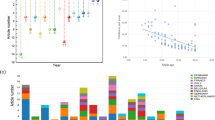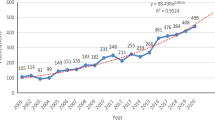Abstract
Despite a growing interest to clinicians and scientists, there is no comprehensive study that examines the global research activity on congenital diaphragmatic hernia (CDH). A search strategy for the Web of Science™ database was designed to identify scientific CDH publications. Research output of countries, institutions, individual authors, and collaborative networks was analyzed. Semi-qualitative research measures including citation rate and h-index were assessed. Choropleth mapping and network diagrams were employed to visualize results. A total of 3669 publications were found, originating from 76 countries. The largest number was published by the USA (n = 1250), the UK (n = 279), and Canada (n = 215). The USA combined the highest number of cooperation articles (n = 152), followed by Belgium (n = 115) and the Netherlands (n = 93). The most productive collaborative networks were established between UK/Belgium (n = 53), Belgium/Spain (n = 47), and UK/Spain (n = 34). Canadian publications received the highest average citation rate (22.8), whereas the USA had the highest country-specific h-index (72). Eighty-five (2.3%) articles were published by international multicenter consortiums and national research networks. The most productive institutions and authors were based in North America and Europe. Over the past decades, CDH research has increasingly become multidisciplinary and numerous innovative therapeutic strategies were introduced. CDH-related research has constantly been progressing, involving today many disciplines with main research endeavors concentrating in a few high-income countries. Recent advances in prenatal interventions and regenerative medicine therapy hold the promise of improving CDH outcome in the 21st century. International collaborations and translational research should be strengthened to allow further evolution in this field.





Similar content being viewed by others
References
Doyle NM, Lally KP (2004) The CDH Study Group and advances in the clinical care of the patient with congenital diaphragmatic hernia. Semin Perinatol 28:174–184
Balayla J, Abenhaim HA (2014) Incidence, predictors and outcomes of congenital diaphragmatic hernia: a population-based study of 32 million births in the United States. J Matern Fetal Neonatal Med 27:1438–1444
McGivern MR, Best KE, Rankin J, Wellesley D, Greenlees R, Addor MC et al (2015) Epidemiology of congenital diaphragmatic hernia in Europe: a register-based study. Arch Dis Child Fetal Neonatal Ed 100:F137–F144
Slovatinek AM (2014) The genetics of common disorders—congenital diaphragmatic hernia. Eur J Med Genet 57:418–423
Keijzer R, Puri P (2010) Congenital diaphragmatic hernia. Semin Pediatr Surg 19:180–185
Tovar JA (2012) Congenital diaphragmatic hernia. Orphanet J Rare Dis 7:1
Ameis D, Khoshgoo N, Keijzer R (2017) Abnormal lung development in congenital diaphragmatic hernia. Semin Pediatr Surg 26:123–128
Kotecha S, Barbato A, Bush A, Claus F, Davenport M, Delacourt C et al (2012) Congenital diaphragmatic hernia. Eur Respir J 39:820–829
van den Hout L, Reiss I, Felix JF, Hop WC, Lally PA, Lally KP et al (2010) Risk factors for chronic lung disease and mortality in newborns with congenital diaphragmatic hernia. Neonatology 98:370–380
Losty PD (2014) Congenital diaphragmatic hernia: where and what is the evidence? Semin Pediatr Surg 23:278–282
Rocha G, Azevedo I, Pinto JC, Guimarães H (2012) Follow-up of the survivors of congenital diaphragmatic hernia. Early Hum Dev 88:255–258
Lally PA, Skarsgard ED (2017) Congenital diaphragmatic hernia: the role of multi-institutional collaboration and patient registries in supporting best practice. Semin Pediatr Surg 26:129–135
Leydesdorff L, Milojević S (2015) Scientometrics. In: Wright JD (ed) International encyclopedia of social and behavioral sciences. Elsevier, New York, pp 322–327
Mingers J, Leydesdorff L (2015) A review of theory and practice in scientometrics. Eur J Oper Res 246:1–19
Groneberg-Kloft B, Fischer TC, Quarcoo D, Scutaru C (2009) New quality and quantity indices in science (NewQIS): the study protocol of an international project. J Occup Med Toxicol 4:16
Hirsch JE (2005) An index to quantify an individual’s scientific research output. Proc Natl Acad Sci USA 102:16569–16572
Groneberg-Kloft B, Scutaru C, Kreiter C, Kölzow S, Fischer A, Quarcoo D (2008) Institutional operating figures in basic and applied sciences: scientometric analysis of quantitative output benchmarking. Health Res Policy Syst 6:6
Braun T, Glänzel W, Grupp H (1995) The scientometric weight of 50 nations in 27 science areas, 1989–1993. Part II. Life sciences. Scientometrics 34:207–237
Greene M (2007) The demise of the lone author. Nature 450:1165
Wagner CS, Jonkers K (2017) Open countries have strong science. Nature 550:32–33
Adams J (2013) Collaborations: the fourth age of research. Nature 497:557–560
Schöffel N, Gfroerer S, Rolle U, Bendels MH, Klingelhöfer D, Groneberg-Kloft B (2017) Hirschsprung disease: critical evaluation of the global research architecture employing scientometrics and density-equalizing mapping. Eur J Pediatr Surg 27:185–191
Fanelli D (2010) Do pressures to publish increase scientists’ bias? An empirical support from US States data. PLoS One 5:e10271
Génova G, Astudillo H, Fraga A (2016) The scientometric bubble considered harmful. Sci Eng Ethics 22:227–235
CDH International (2018) A global initiative to stop congenital diaphragmatic hernia. https://cdhi.org. Accessed 8 July 2018
Grivell RM, Andersen C, Dodd JM (2015) Prenatal interventions for congenital diaphragmatic hernia for improving outcomes. Cochrane Database Syst Rev 11:CD008925
Persico N, Fabietti I, Ciralli F, Gentilino V, D’Ambrosi F, Boito S et al (2017) Fetoscopic endoluminal tracheal occlusion in fetuses with severe diaphragmatic hernia: a three-year single-center experience. Fetal Diagn Ther 41:215–219
Belfort MA, Olutoye OO, Cass DL, Olutoye OA, Cassady CI, Mehollin-Ray AR et al (2017) Feasibility and outcomes of fetoscopic tracheal occlusion for severe left diaphragmatic hernia. Obstet Gynecol 129:20–29
Ruano R, Yoshisaki CT, da Silva MM, Ceccon ME, Grasi MS, Tannuri U et al (2012) A randomized controlled trial of fetal endoscopic tracheal occlusion versus postnatal management of severe isolated congenital diaphragmatic hernia. Ultrasound Obstet Gynecol 39:20–27
Dekoninck P, Gratacos E, Van Mieghem T, Richter J, Lewi P, Ancel AM et al (2011) Results of fetal endoscopic tracheal occlusion for congenital diaphragmatic hernia and the set up of the randomized controlled TOTAL trial. Early Hum Dev 87:619–624
Harrison MR, Keller RL, Hawgood SB, Kitterman JA, Sandberg PL, Farmer DL et al (2003) A randomized trial of fetal endoscopic tracheal occlusion for severe fetal congenital diaphragmatic hernia. N Engl J Med 349:1916–1924
Araujo Júnior E, Tonni G, Martins WP, Ruano R (2017) Procedure-related complications and survival following fetoscopic endotracheal occlusion (FETO) for severe congenital diaphragmatic hernia: systematic review and meta-analysis in the FETO era. Eur J Pediatr Surg 27:297–305
Al-Maary J, Eastwood MP, Russo FM, Deprest JA, Keijzer R (2016) Fetal tracheal occlusion for severe pulmonary hypoplasia in isolated congenital diaphragmatic hernia: a systematic review and meta-analysis of survival. Ann Surg 264:929–933
Deprest J, Gucciardo L, Eastwood P, Zia S, Jimenez J, Russo F et al (2014) Medical and regenerative solutions for congenital diaphragmatic hernia: a perinatal perspective. Eur J Pediatr Surg 24:270–277
Deprest J, Brady P, Nicolaides K, Benachi A, Berg C, Vermeesch J et al (2014) Prenatal management of the fetus with isolated congenital diaphragmatic hernia in the era of the TOTAL trial. Semin Fetal Neonatal Med 19:338–348
Benachi A, Cordier AG, Cannie M, Jani J (2014) Advances in prenatal diagnosis of congenital diaphragmatic hernia. Semin Fetal Neonatal Med 19:331–337
Senat MV, Bouchghoul H, Stirnemann J, Vaast P, Boubnova J, Begue L et al (2018) Prognosis of isolated congenital diaphragmatic hernia using lung-to-head circumference ratio: variability across centers in a national perinatal network. Ultrasound Obstet Gynecol 51:208–213
Snoek KG, Peters NCJ, van Rosmalen J, van Heijst AFJ, Eggink AJ, Sikkel E et al (2017) The validity of the observed-to-expected lung-to-head ratio in congenital diaphragmatic hernia in an era of standardized neonatal treatment; a multicenter study. Prenat Diagn 37:658–665
Russo FM, Eastwood MP, Keijzer R, Al-Maary J, Toelen J, Van Mieghem T et al (2017) Lung size and liver herniation predict need for extracorporeal membrane oxygenation but not pulmonary hypertension in isolated congenital diaphragmatic hernia: systematic review and meta-analysis. Ultrasound Obstet Gynecol 49:704–713
Kastenholz KE, Weis M, Hagelstein C, Weiss C, Kehl S, Schaible T et al (2016) Correlation of observed-to-expected MRI fetal lung volume and ultrasound lung-to-head ratio at different gestational times in fetuses with congenital diaphragmatic hernia. AJR Am J Roentgenol 206:856–866
Bouchghoul H, Senat MV, Storme L, de Lagausie P, Begue L, Khen-Dunlop N et al (2015) Congenital diaphragmatic hernia: does gestational age at diagnosis matter when evaluating morbidity and mortality? Am J Obstet Gynecol 213:535.e1–535.e7
Morini F, Lally KP, Lally PA, Crisafulli RM, Capolupo I, Bagolan P (2017) Treatment strategies for congenital diaphragmatic hernia: change sometimes comes bearing gifts. Front Pediatr 5:195
Harting MT, Lally KP (2014) The congenital diaphragmatic hernia study group registry update. Semin Fetal Neonatal Med 19:370–375
Donahoe PK, Longoni M, High FA (2016) Polygenic causes of congenital diaphragmatic hernia produce common lung pathologies. Am J Pathol 186:2532–2543
Stege G, Fenton A, Jaffray B (2003) Nihilism in the 1990s: the true mortality of congenital diaphragmatic hernia. Pediatrics 112:532–535
Mah VK, Zamakhshary M, Mah DY, Cameron B, Bass J, Bohn D et al (2009) Absolute vs relative improvements in congenital diaphragmatic hernia survival: what happened to “hidden mortality”. J Pediatr Surg 44:877–882
Putnam LR, Harting MT, Tsao K, Morini F, Yoder BA, Luco M et al (2016) Congenital diaphragmatic hernia defect size and infant morbidity at discharge. Pediatrics 138:e20162043
Hollinger LE, Harting MT, Lally KP (2017) Long-term follow-up of congenital diaphragmatic hernia. Semin Pediatr Surg 26:178–184
Morini F, Valfrè L, Bagolan P (2017) Long-term morbidity of congenital diaphragmatic hernia: a plea for standardization. Semin Pediatr Surg 26:301–310
Tracy S, Chen C (2014) Multidisciplinary long-term follow-up of congenital diaphragmatic hernia: a growing trend. Semin Fetal Neonatal Med 19:385–391
World Health Organization (2018) Hinari access to research for Health Programme. http://www.who.int/hinari/en. Accessed 8 July 2018
Research4Life (2018) Access to research in the developing world. http://www.research4life.org. Accessed 8 July 2018
Van Leeuwen TN, Moed HF, Tijssen RJW, Visser MS, Van Raan AFJ (2001) Language biases in the coverage of the Science Citation Index and its consequences for international comparisons of national research performance. Scientometrics 51:335–346
Campbell FM (1990) National bias: a comparison of citation practices by health professionals. Bull Med Libr Assoc 78:376–382
Link AM (1998) US and non-US submissions: an analysis of reviewer bias. JAMA 280:246–247
Garfield E (2001) Impact factors, and why they won’t go away. Nature 411:522
Bartneck C, Kokkelmans S (2011) Detecting h-index manipulation through self-citation analysis. Scientometrics 87:85–98
Egghe L (2006) Theory and practice of the g-index. Scientometrics 69:131–152
Merton RK (1968) The Matthew effect in science. Science 159:56–63
Funding
No external funding was received by any of the authors in support of this work.
Author information
Authors and Affiliations
Corresponding author
Ethics declarations
Conflict of interest
The authors declare that they have no conflict of interest.
Ethical approval
This article does not contain any studies with human participants or animals performed by any of the authors.
Informed consent
For this type of study, informed consent was not required.
Rights and permissions
About this article
Cite this article
Friedmacher, F., Pakarinen, M.P. & Rintala, R.J. Congenital diaphragmatic hernia: a scientometric analysis of the global research activity and collaborative networks. Pediatr Surg Int 34, 907–917 (2018). https://doi.org/10.1007/s00383-018-4304-7
Accepted:
Published:
Issue Date:
DOI: https://doi.org/10.1007/s00383-018-4304-7




